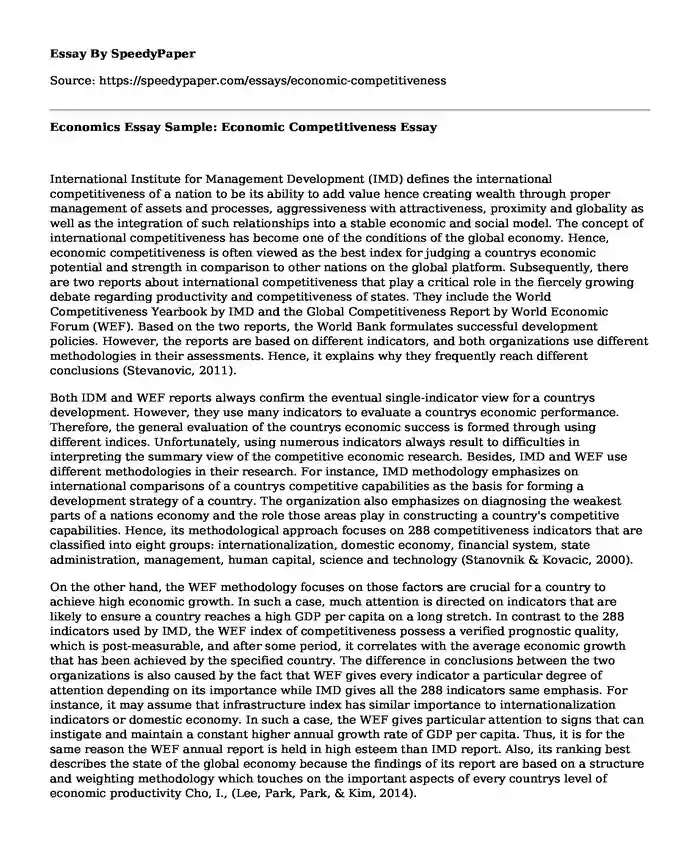International Institute for Management Development (IMD) defines the international competitiveness of a nation to be its ability to add value hence creating wealth through proper management of assets and processes, aggressiveness with attractiveness, proximity and globality as well as the integration of such relationships into a stable economic and social model. The concept of international competitiveness has become one of the conditions of the global economy. Hence, economic competitiveness is often viewed as the best index for judging a countrys economic potential and strength in comparison to other nations on the global platform. Subsequently, there are two reports about international competitiveness that play a critical role in the fiercely growing debate regarding productivity and competitiveness of states. They include the World Competitiveness Yearbook by IMD and the Global Competitiveness Report by World Economic Forum (WEF). Based on the two reports, the World Bank formulates successful development policies. However, the reports are based on different indicators, and both organizations use different methodologies in their assessments. Hence, it explains why they frequently reach different conclusions (Stevanovic, 2011).
Both IDM and WEF reports always confirm the eventual single-indicator view for a countrys development. However, they use many indicators to evaluate a countrys economic performance. Therefore, the general evaluation of the countrys economic success is formed through using different indices. Unfortunately, using numerous indicators always result to difficulties in interpreting the summary view of the competitive economic research. Besides, IMD and WEF use different methodologies in their research. For instance, IMD methodology emphasizes on international comparisons of a countrys competitive capabilities as the basis for forming a development strategy of a country. The organization also emphasizes on diagnosing the weakest parts of a nations economy and the role those areas play in constructing a country's competitive capabilities. Hence, its methodological approach focuses on 288 competitiveness indicators that are classified into eight groups: internationalization, domestic economy, financial system, state administration, management, human capital, science and technology (Stanovnik & Kovacic, 2000).
On the other hand, the WEF methodology focuses on those factors are crucial for a country to achieve high economic growth. In such a case, much attention is directed on indicators that are likely to ensure a country reaches a high GDP per capita on a long stretch. In contrast to the 288 indicators used by IMD, the WEF index of competitiveness possess a verified prognostic quality, which is post-measurable, and after some period, it correlates with the average economic growth that has been achieved by the specified country. The difference in conclusions between the two organizations is also caused by the fact that WEF gives every indicator a particular degree of attention depending on its importance while IMD gives all the 288 indicators same emphasis. For instance, it may assume that infrastructure index has similar importance to internationalization indicators or domestic economy. In such a case, the WEF gives particular attention to signs that can instigate and maintain a constant higher annual growth rate of GDP per capita. Thus, it is for the same reason the WEF annual report is held in high esteem than IMD report. Also, its ranking best describes the state of the global economy because the findings of its report are based on a structure and weighting methodology which touches on the important aspects of every countrys level of economic productivity Cho, I., (Lee, Park, Park, & Kim, 2014).
In conclusion, the difference in WEF and IMD conclusion is caused by a difference in research methodology. That is, IDM not only combines 288 indicators but also gives similar attention to each of them. On the other hand, WEF research methodology is based on critical economic indicators in a country which when measured over a period correlated with the achieved economic growth.
References
Cho, I., Lee, K., Park, H., Park, M., & Kim, J. K. (2014). Development of an Index for Evaluating National Quality Competitiveness based on WEF and IMD Compiled Indices. Quality Innovation Prosperity, 18(1), 73-92.
Stevanovic, A. T. (2011). COMPARATIVE ANALYSIS OF INDICATORS OF INTERNATIONAL COMPETITIVENESS. Megatrend Review, 8(2).
Stanovnik, P., & Kovacic, A. (2000). Measuring competitiveness of national economies with emphasis on Slovenia. Ljubljana: Institute for Economic Research.
Cite this page
Economics Essay Sample: Economic Competitiveness. (2019, Oct 10). Retrieved from https://speedypaper.com/essays/economic-competitiveness
Request Removal
If you are the original author of this essay and no longer wish to have it published on the SpeedyPaper website, please click below to request its removal:
- Spies by Michael Frayne - Free Essay on Literary Analysis
- Literary Essay on How the Theme Is Represented in Sonny's Blues
- Free Essay Example on Promoting Health Intervention Event
- Essay Example: Struggles for Individualism Against Societal Norms in The Scarlet Letter
- Essay Sample about the Organizational Behavior Problem
- Free Essay: To What Extent Have the Flattening Wages Been Responsible for the Dwindling Middle Class?
- Free Essay: How Men and Women Have Differences in Income
Popular categories





